There were some good horses lining up for the Lightning. Sunlight immediately caught my eye and looked outstanding. I nearly put my book down since there was no point in looking at any other horse. But I persisted, after all $1.60 for the place is not my sort of bet. Osborne Bulls looked good. Relaxed, big, strong. I wrote off Written By, misbehaving with the two strappers. The speedy Divine Quality needed guidance from the clerk to make it around the yard. Not a good sign. Graff was OK. In Her Time was a bit head up when she went past me and showing a bit of teeth. With hindsight, Osborne Bulls should have been the place bet.
- In Her Time
- Osborne Bulls
- Sunlight
- Written By
- Graff
- Divine Quality
But it was a good day with two standouts. Intuition in the third streeted them and Talented in the two-year-old ran a bold second to Microphone. Always happy with two out of two.



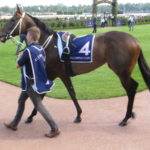
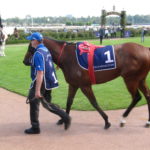
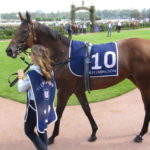
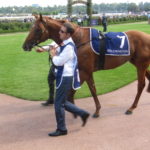
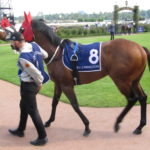
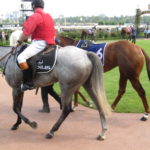
Geoffrey, lovely to see so many horses not wearing crossover nose bands! Attended another UK jumps meeting(Ascot), 65 out of 83 (78%) with crossovers and 68/83(82%) with any type of headgear (crossovers, winkers, visors, blinkers). Excluding every horse with headgear left a pool of 1, 2, 1, 2, 0, 2, 0, 4, 3 to choose from on the nine race card. I suspect this is not where I want to be! I’m guessing your position on crossovers (with the white fluffy protector at the cross-point) remains unaltered.
I noticed Osbourne Bulls was wearing a hood. Was it a windy day? Is wearing a hood ever a negative or is it only negative if accompanied by certain other behaviours?
Osborne Bulls was your 2nd choice but you said you could have backed him. Were you adopting the approach described in your 1st book, whereby you discard your first choice (typically the favourite) when the odds fall below the threshold?
How do you define a standout? Is it when there is “clear blue water” between the standout and the other horses in terms of behaviour, or is it when only all the other horses have been crossed off leaving one horse remaining?
Trevor, my view on cross-over nosebands is largely unaltered. But bear in mind the best horse I have ever seen (and backed) was So You Think, who wore one. Such a shame he didn’t stay with Bart. I like the white piece of fluff as it will reduce the severity of the crossover and there are some new rubber ones with a round cross-section which also seem to be less severe.
It wasn’t windy. We call the hood “ear muffs” and they have exploded in popularity. Many horses only wear them in the pre-parade and discard them for the race. They calm the horse and are a definite positive. I regret not backing Osborne Bulls once Sunlight was too short.
A standout is both of those things. Most commonly when I have crossed out all the opposition, but also when the horse’s behaviour is clearly superior. I used to calculate behavioural handicaps, but I know them so well I don’t need to do that now!
Geoffrey,
Thanks for your advice and observations. I suspect that crossover nosebands are so common in jumps racing because the horse is required to navigate obstacles and the rider needs more control. The use of restrictive nosebands is the subject of research (Paul McGreevy, University of Sydney). Tight nosebands appear to inhibit yawning, swallowing, licking etc. which seems to make sense (note there has been some criticism of the research). Therefore tight nosebands may well stop these and other mouth related behaviours being observed at the racecourse. I quite like this quote from a paper by Doherty et al (2017), Noseband use in equestrian sports – an international study, “The current findings may reflect riders’ efforts to address such problems, at least partly, by tightening nosebands, rather than putting the required time into training horses to slow, stop or stand still from a rein cue”. A similar argument may apply to racehorses; there isn’t enough time for trainers to undertake the necessary schooling or it’s just easier to deploy a crossover. So perhaps I should wait for warmer weather and focus on flat racing where the full range of behaviours can be observed. Also, as you reported in Watching Racehorses, races over 1700 metres or more were less able to discriminate between winners and losers, and given that the minimum distance for a jumps race in the UK is 3200 metres, that same rule may apply, noting that a flat racehorse that stays 2000 metres can quite often cope with a hurdles race over 3200 metres.
On the subject of selection, you are left with three horses where A is better than B, and B is better than C on the behavioural handicap. A and B are both eliminated because their odds are not good enough (<1.8) but the odds are above the threshold for C, would you still back C?
No. Theoretically only one place is then available so it becomes a win bet.
Apologies Geoffrey I should have been clearer.
Let’s say it’s a 10 horse race, and you have discarded seven horses and three remain (A, B and C). As before A is better than B, and B is better than C on the behavioural handicap. A and B are eliminated solely because their place odds are <1.8 and you are left with C whose odds are above the threshold. I assume C then becomes the place bet.
How do you approach races with less than five horses where you find a selection? Would you go for a win bet and what odds would be acceptable?
No. I don’t bet on C because A and B are running against me and only one place is now theoretically available. I would not bet on races with less than five horses.